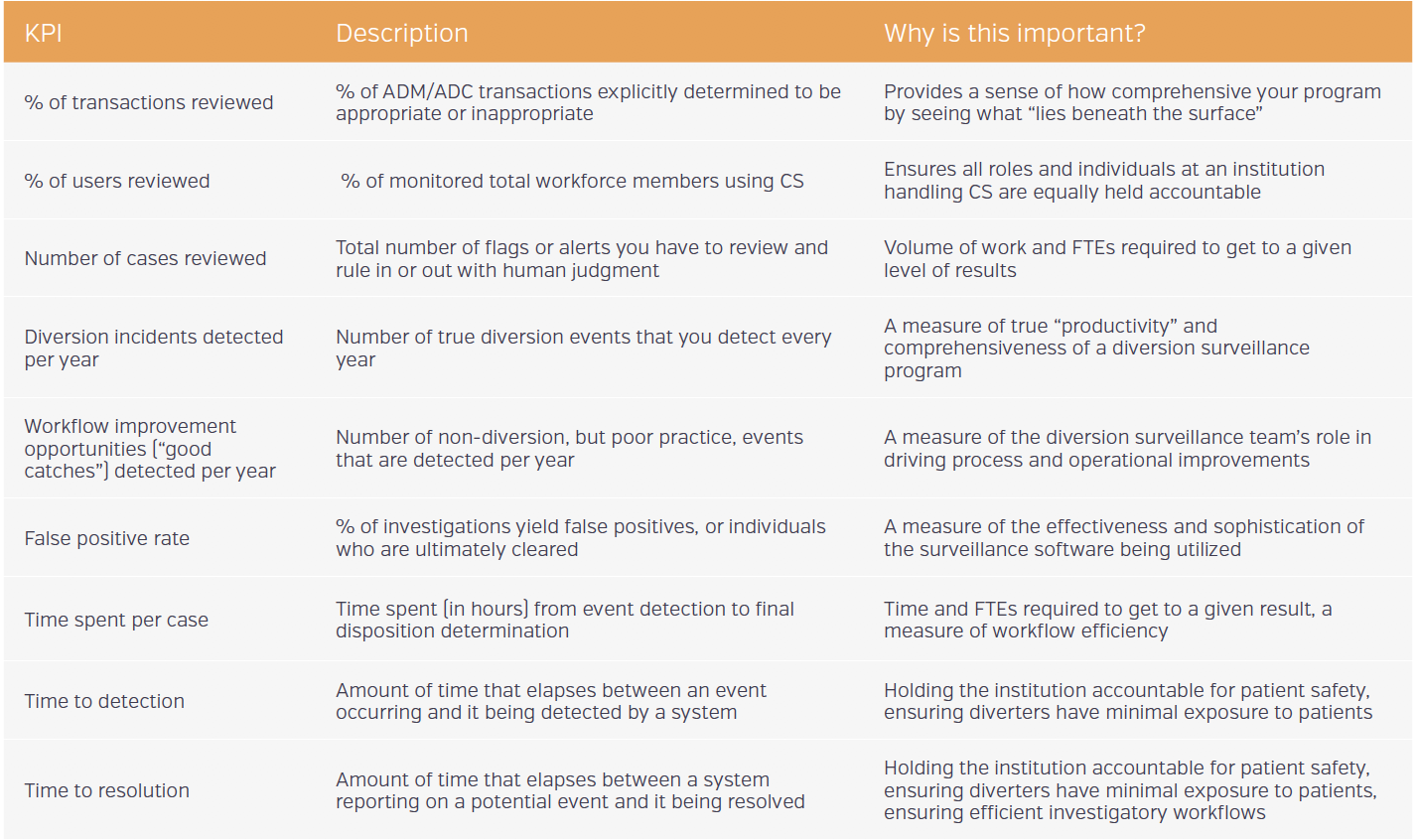Share this

How to Develop Key Performance Indicators to Monitor Success for Your Drug Diversion Monitoring Program
by Robert Lord, Co-founder, Protenus on November 12, 2019
For any drug diversion monitoring program, the team responsible for the success of the program will need to determine how to accurately measure its performance by using Key Performance Indicators (KPIs). These metrics also ensure accountability for the program’s overall success, evaluating and recognizing the program’s strengths and challenges while ensuring the team addresses the needs of the program in a timely fashion.
The importance that KPIs hold becomes evident when measuring the effectiveness of your diversion program over time. Though each organization must determine their unique blend of KPIs that will lead to the institution’s desired outcomes, industry leaders across top healthcare organizations have created some recommendations to help measure the ongoing success of your program.
Read the entire Controlled Substance Diversion Monitoring Playbook to review all eight steps for creating a proactive diversion monitoring program. This playbook is a helpful guide for healthcare organizations that are either starting, in the midst of creating, or optimizing their current drug diversion monitoring program.
Review 100% of transactions and users
Percent of transactions reviewed
Many organizations presently achieve far below the ideal 100% review and documentation of transactions of controlled substances. This may be due to resource, technology, or personnel limitations. Report-running and periodic reviews only result in capturing perhaps 1-5% of total transactions, which provides an opportunity to catch some events, but is ultimately an unacceptable portion of transactions. Striving for the ability to prove that 100% of all transactions have been audited is critically important.
Percent of users reviewed
This KPI is related to the percent of transactions reviewed, but measures coverage across your organization’s personnel to ensure that all clinical environments are being monitored. For instance, if you are reviewing 100% of electronically-logged transactions, but still have a paper-and-pencil policy for anesthesia and no review of anesthesiologists, you may have a significant gap, and one that could easily be exploited.
Diversion incidents detected per year
This is a critical metric for any diversion monitoring program. Currently, it is generally accepted that an increase in this number usually comes from improvement in monitoring, rather than an actual increase in diversions. The more diversion incidents you detect and resolve, the more you are able to create accountability and foster culture change at your institution.

List of Key Performance Indicators recommended in the 2019 Practical Diversion Monitoring Playbook
Monitor false positives and “good catches”
False positive rate
The false positive rate for traditional diversion monitoring programs is unacceptably high, yet simultaneously a necessary evil. A false positive result from any investigation is neither an opportunity for improvement nor an identified diversion incident. High false positive rates are very common with report-based methodologies for detection, which focus on looking at items like volume discrepancies, high volumes of opioids dispensed, or similar broad metrics that often have reasonable explanations.
“Good catch” rate
An organization’s rate of “good catches” results from legitimate opportunities for quality or practice improvement that are due to one’s diversion detection methodology. How much a program wants to focus on “good catches” can depend on the resources that exist for an institution, but incidents like inappropriate batches of wasting, delayed administration or documentation, or questionable waste witnessing practices all fall under the umbrella of cultural norms or individual performance that should be improved.
Improve time to detection and case resolution
Time spent per case
This critical metric is currently at troubling levels for many health systems. Many health systems report spending dozens of hours to resolve complex cases. This is time spent reviewing reports, gathering data, making requests from different departments for resources, and ultimately writing up conclusions. Driving improvement in these statistics not only allows diversion teams to focus on more strategic goals but also speeds time to resolution, another KPI with safety implications.
Time to detection
This metric is all about patient and workforce safety; the longer it takes to detect a diverter, the more damage they can do. Consider the number of patients that can be exposed to an impaired diverter, continuously increasing the health system’s liability. In addition to this, the diverter becomes more susceptible to an overdose of their own. Even if this does not occur, the likelihood of successful rehabilitation may drop as their addiction levels increase over this time period.
Time to resolution
The amount of time that it currently takes to resolve a case is largely a measure of workflow efficiency. This efficiency is reduced when diversion teams have to pass cases back and forth between departments. For instance, if a diversion workflow needs pharmacy review, then is handed off to nursing, security, then back to pharmacy, this process will likely take weeks (if not longer). However, if all of the information generated by those handoffs is presented up-front, a timely resolution may be reached within minutes, or possibly hours if an interview is required.
The key to measuring the success of your drug diversion monitoring program is to review the KPIs in a historical context (when possible) and to use your current methodologies to decide which ones you want to focus on improving. The team can then create actions to ensure improvement. Some interventions, like standardized documentation, may reduce time to resolution in a targeted sense. Others, like implementing a Healthcare Compliance Analytics platform, may improve several KPIs simultaneously. Whatever you choose to do, the key is to start tracking and reporting on these metrics to show progress and hold all teams involved accountable.
Share this
- December 1, 2024 (3)
- November 1, 2024 (1)
- October 1, 2024 (2)
- September 1, 2024 (1)
- August 1, 2024 (1)
- July 1, 2024 (1)
- June 1, 2024 (1)
- May 1, 2024 (1)
- March 1, 2024 (2)
- February 1, 2024 (3)
- January 1, 2024 (1)
- December 1, 2023 (1)
- November 1, 2023 (3)
- October 1, 2023 (3)
- September 1, 2023 (1)
- August 1, 2023 (1)
- July 1, 2023 (2)
- April 1, 2023 (1)
- March 1, 2023 (1)
- February 1, 2023 (1)
- December 1, 2022 (3)
- November 1, 2022 (3)
- October 1, 2022 (1)
- September 1, 2022 (1)
- August 1, 2022 (2)
- June 1, 2022 (4)
- May 1, 2022 (5)
- April 1, 2022 (1)
- March 1, 2022 (4)
- February 1, 2022 (3)
- November 1, 2021 (2)
- October 1, 2021 (3)
- September 1, 2021 (3)
- August 1, 2021 (3)
- July 1, 2021 (4)
- June 1, 2021 (2)
- May 1, 2021 (2)
- April 1, 2021 (2)
- March 1, 2021 (5)
- February 1, 2021 (1)
- January 1, 2021 (1)
- December 1, 2020 (1)
- November 1, 2020 (2)
- October 1, 2020 (2)
- September 1, 2020 (3)
- August 1, 2020 (2)
- July 1, 2020 (2)
- June 1, 2020 (6)
- May 1, 2020 (3)
- April 1, 2020 (4)
- March 1, 2020 (2)
- February 1, 2020 (4)
- January 1, 2020 (2)
- December 1, 2019 (2)
- November 1, 2019 (1)
- October 1, 2019 (1)
- September 1, 2019 (1)
- August 1, 2019 (1)
- June 1, 2019 (1)
- April 1, 2019 (1)
- February 1, 2019 (1)
- January 1, 2019 (1)
- December 1, 2018 (2)
- November 1, 2018 (2)
- October 1, 2018 (2)
- September 1, 2018 (3)
- August 1, 2018 (1)
- July 1, 2018 (2)
- June 1, 2018 (2)
- May 1, 2018 (1)
- April 1, 2018 (1)
- March 1, 2018 (2)
- February 1, 2018 (6)
- January 1, 2018 (2)
- September 1, 2017 (2)
- August 1, 2017 (2)
- June 1, 2017 (2)
- May 1, 2017 (1)
- April 1, 2017 (1)
- March 1, 2017 (2)
- February 1, 2017 (5)
- January 1, 2017 (2)
- December 1, 2016 (3)
- November 1, 2016 (5)
- October 1, 2016 (4)
- September 1, 2016 (8)
- August 1, 2016 (4)
- July 1, 2016 (4)
Subscribe by email
You May Also Like

Conserving Resources with Compliance Analytics: A 5-Step Implementation Guide

Enabling Greater Healthcare Efficiency with Protenus AI Technology

.png?width=1000&height=140&name=Bluesight%20%2B%20Protenus%20Logo%20%20(1).png)